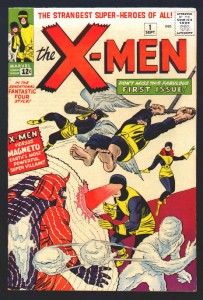A runaway hit in both comic shops in the ’80s and ’90s and movie theatres every few years since 2000, the X-Men were the heavy hitters in Marvel’s lineup for decades. However, it’s easy to forget that for much of the series’ existence, the X-Men were distant third-stringers in the Marvel Universe, with their comic book often relegated to reprints and even a lengthy stretch in cancellation. Much like one of their members, though, the X-Men would rise from the ashes, eventually becoming not only the company’s most popular and profitable book, but leading its expansion into toys, animation and the silver screen. But we’re getting ahead of ourselves…
The X-Men first appeared in September 1963, in their first issue, X-MEN #1. Yet another creation of Marvel’s Silver-Age team supreme, writer/editor Stan Lee and artist/storyteller Jack Kirby, the X-Men started off with a deceptively simple premise, and one that still holds much significance to this day. Professor Charles Xavier, the most powerful mutant telepath on the planet, has founded Xavier’s School for Gifted Youngsters, a haven for children who were born just a little different: mutants.
Later defined as homo superior, mutants are those born with extra powers or abilities that normal humans lack. At Xavier’s School, these children can learn to use their powers safely, without fear of persecution from a world that is growing increasingly fearful of mutants. Professor Xavier’s students, having sufficiently mastered their powers, often continue to serve their mentor as members of the “X-Men,” protecting the world against the machinations of other mutants who do not share Xavier’s more enlightened philosophy. Rather than co-existing peacefully with normal humans, these “evil” mutants seek conquest.
Lee’s premise is ingenious on a number of levels. The central theme of the series, young people being ostracized for being different, is a perfect metaphor for the isolation and sense of removal most teens feel going through adolescence. Further, the series’ continuing message of tolerance translates to readers of all races, faiths and orientations. Ironically, the concept of mutants came about because writer Stan Lee was tired of coming up with new origins. In his book SON OF ORIGINS OF MARVEL COMICS, Stan relates how, when he was dreaming up his newest team book, he was having trouble coming up with new and exciting ways for his heroes to gain their superpowers. Utilizing the idea of mutation seemed a great, easy way to get a series going without devoting a lot of time to an origin, and as Lee put it, “whatever power we conceived of could be justified on the basis of its being a mutated trait.” In fact, Stan wanted to title his new book THE MUTANTS, but Marvel’s then-publisher, Martin Goodman, ixnayed the idea, feeling that little kids wouldn’t understand the title. Sent back to the drawing board, Lee reasoned that since mutants are people with something “extra,” these “extra-people” could be dubbed the X-Men.
The original team was close to what moviegoers have seen; Professor Xavier was of course present, as was Scott Summers, a.k.a. Cyclops, and Jean Grey, who was then referred to as Marvel Girl. The other members included Bobby Drake, whose ability to generate and control snow and ice earned him the nickname Iceman, Henry McCoy, referred to as the Beast due to his apelike build and oversized hands and feet, and trust-fund rich boy Warren Worthington III, better known as the Angel, thanks to his enormous feathered wings. Joining the team later were Cyclops’ brother Alex, who could generate concussive bolts of energy as Havok, and his girlfriend Lorna Dane (also known as Polaris), who was able to control the forces of magnetism.
The series wasn’t really a big hit like Spider-Man and the Fantastic Four. The book suffered through some lackluster art by Werner Roth after Kirby left the book, and although writer Roy Thomas and artist Neal Adams did some outstanding work starting in 1969, it wasn’t enough to save the series, and X-MEN was cancelled with issue #66 in 1970, with reprints continuing to be published for another 25 issues. The characters did remain a presence, appearing here and there as guest-stars in other Marvel books.


Jack Kirby always maintained that he suggested the mutation idea to Stan, as he was an avid reader of science and science fiction. Looking over the body of Kirby’s work, I would tend to give him the benefit of the doubt, as science was always a greater factor in the Lee and Kirby collaborations than Stan’s other work (even Spider-Man).